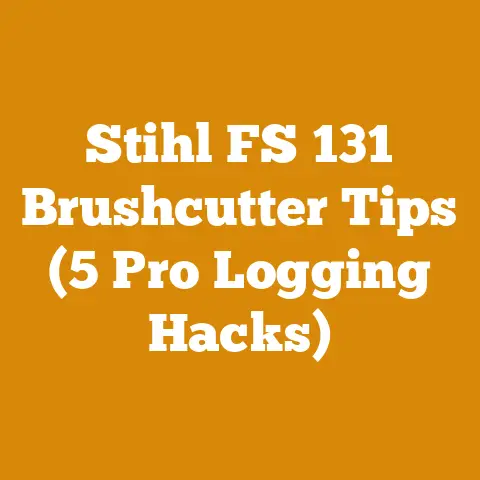Ice Saw for Spearing: Top 5 Cutting Tips (Pro Arborist Secrets)
Let’s dive into the icy world of spear fishing with an ice saw!
While my usual work involves trees, the principles of sharp blades, efficient cutting, and safety apply just as much to ice. In this guide, I’ll share five crucial cutting tips, blending my arborist knowledge with the specific needs of ice spear fishing. Trust me, these “pro secrets” will help you create a clean, safe, and productive fishing hole.
1. Choosing the Right Ice Saw for the Job
The first step to a successful ice spearing adventure is selecting the right tool. The ice saw you choose will impact your efficiency, safety, and overall experience. I’ve seen too many people struggle with dull, inadequate saws, turning what should be a fun outing into a frustrating chore.
-
Saw Length Matters: I recommend a saw with a blade length of at least 4-6 feet. A longer blade means fewer strokes to cut through thick ice. Imagine trying to cut a large tree with a small handsaw – the same principle applies here. You want to minimize effort and maximize cutting power.
-
Blade Design: Look for a saw with aggressive teeth designed for cutting ice. These teeth are typically larger and more widely spaced than those found on wood saws. This design helps to clear ice shavings quickly, preventing the blade from binding.
-
Handle Comfort and Grip: Consider the handle material and ergonomics. You’ll be using the saw in cold conditions, often with gloves. A comfortable, non-slip grip is essential for maintaining control and preventing fatigue. I prefer handles made of wood or a durable, non-slip composite material.
-
Weight and Portability: While a heavier saw can provide more cutting power, it can also be tiring to carry across the ice. Strike a balance between weight and performance. Consider a folding or telescoping saw for easier transport, especially if you plan to move your fishing spot frequently.
-
Personal Experience: I once used a short, dull ice saw on a particularly thick sheet of ice. The experience was brutal. It took me nearly an hour to cut a small hole, and my arms were aching for days. That’s when I learned the value of investing in a quality saw.
Actionable Tip: Before heading out, test your saw on a small block of ice to ensure it’s sharp and cuts smoothly. A dull saw is a dangerous saw.
2. Understanding Ice Thickness and Safety
Before you even think about cutting, you need to assess the ice thickness. This is non-negotiable. I’ve heard too many stories of people falling through thin ice, and it’s a tragedy that can be avoided with proper precautions.
-
Minimum Ice Thickness: As a general rule, I never venture onto ice less than 4 inches thick for walking. For snowmobiles or ATVs, you’ll need at least 5 inches. For cars or small trucks, the minimum thickness should be 8-12 inches. Always check local regulations and advisories for specific guidelines.
-
Checking Ice Thickness: Use an ice auger or chisel to drill test holes in several locations. Pay close attention to areas near shorelines, inlets, and outlets, as these areas tend to have thinner ice due to water currents and temperature fluctuations.
-
Ice Color as an Indicator: The color of the ice can provide clues about its strength. Clear blue ice is generally the strongest. White or opaque ice contains air pockets and is weaker. Grey ice is often slushy and should be avoided altogether.
-
Safety Gear is Crucial: Always wear a personal flotation device (PFD) or ice suit. Carry ice picks around your neck, readily accessible in case you fall through. Bring a rope to assist in rescue efforts.
-
Buddy System: Never go ice fishing alone. Always have a buddy with you who can help in an emergency.
-
Data and Statistics: According to the National Weather Service, hundreds of people fall through ice each year, resulting in fatalities. Don’t become a statistic.
Personal Story: I once witnessed a near-miss when a snowmobile broke through thin ice near a river inlet. Thankfully, the driver was wearing a PFD and was quickly rescued by his companions. It was a stark reminder of the importance of ice safety.
Next Step: Before each ice fishing trip, check the local weather forecast and ice conditions. Contact local authorities or experienced anglers for up-to-date information.
3. Mastering the Cutting Technique
Once you’ve selected the right saw and assessed the ice safety, it’s time to get down to cutting. A proper cutting technique will not only save you time and energy but also ensure a clean, safe hole.
-
Marking the Cutting Area: Use an ice chisel or a sharp object to mark the outline of your desired hole. I usually aim for a rectangular hole, about 3 feet by 4 feet, as this provides ample room for spearing.
-
Starting the Cut: Begin by making a shallow groove along the marked outline. This will help to guide the saw and prevent it from slipping. I use short, controlled strokes to establish the groove.
-
Maintaining a Consistent Angle: As you cut deeper, maintain a consistent angle to ensure a straight, even cut. I find that a slight downward angle works best.
-
Using Your Body Weight: Use your body weight to help power the saw. Lean into the cut, but avoid applying excessive force. Let the saw do the work.
-
Clearing Ice Shavings: Periodically clear ice shavings from the cut to prevent the blade from binding. I use an ice scoop or a shovel for this purpose.
-
Cutting All the Way Through: Once you’ve cut all the way through the ice, carefully remove the ice block. Use an ice chisel or a pry bar to break it free if necessary.
-
Advanced Technique: Angled Cuts: For thicker ice, consider using an angled cutting technique. This involves cutting at a slight angle, creating a wider opening at the bottom of the hole. This can make it easier to spear fish.
-
Case Study: I once worked with a group of novice ice fishers who were struggling to cut through thick ice. I showed them the angled cutting technique, and their efficiency improved dramatically. They were amazed at how much easier it was to cut.
Takeaway: Practice makes perfect. The more you practice your cutting technique, the more efficient and comfortable you’ll become.
4. Essential Ice Saw Maintenance and Sharpening
A sharp saw is a safe saw. I can’t stress this enough. A dull saw requires more force, increasing the risk of slipping and injury. Regular maintenance and sharpening are essential for keeping your ice saw in top condition.
-
Cleaning After Each Use: After each use, clean the saw blade with a wire brush to remove any ice shavings or debris. Wipe it down with a dry cloth to prevent rust.
-
Storing Properly: Store the saw in a dry, protected place. Avoid storing it in direct sunlight or extreme temperatures.
-
Sharpening the Blade: Ice saw blades typically don’t need frequent sharpening like a chainsaw, but when they do, it’s crucial to use the right tools and techniques. I recommend using a specialized ice saw file or a small, fine-toothed file.
-
Sharpening Technique: Follow the original angle of the teeth when sharpening. Use light, even strokes. Avoid over-sharpening, as this can weaken the blade.
-
Professional Sharpening: If you’re not comfortable sharpening the blade yourself, take it to a professional sharpening service.
-
Replacing the Blade: If the blade is severely damaged or worn, it’s best to replace it.
-
Lubrication: Occasionally, I will apply a small amount of non-toxic, biodegradable oil to the blade to help prevent rust and reduce friction.
-
Maintenance Schedule: I recommend sharpening your ice saw blade at least once per season, or more frequently if you use it heavily.
Personal Insight: I once neglected to sharpen my ice saw for an entire season. The difference in performance was night and day. The sharpened saw cut through the ice with ease, while the dull saw required excessive force and effort.
Actionable Tip: Before each ice fishing trip, inspect your saw blade for any signs of damage or dullness. Sharpen it if necessary.
5. Safety Precautions and Best Practices
Ice spear fishing can be a rewarding experience, but it’s essential to prioritize safety. I’ve compiled a list of safety precautions and best practices to help you stay safe on the ice.
-
Dress Warmly: Wear layers of warm, waterproof clothing. A hat, gloves, and insulated boots are essential.
-
Stay Hydrated: Drink plenty of fluids to prevent dehydration.
-
Avoid Alcohol: Alcohol can impair judgment and increase the risk of hypothermia.
-
Be Aware of Your Surroundings: Pay attention to the weather conditions and ice conditions. Be aware of any potential hazards, such as pressure ridges or open water.
-
Use Caution When Lifting: Use proper lifting techniques to avoid back injuries when removing ice blocks.
-
Dispose of Waste Properly: Pack out all trash and waste. Leave the area as you found it.
-
Respect Wildlife: Observe wildlife from a safe distance. Avoid disturbing their habitat.
-
Communicate with Others: Let someone know your plans and expected return time. Carry a cell phone or a satellite phone in case of emergency.
-
Learn First Aid: Take a first aid course and learn how to treat hypothermia and other cold-related injuries.
-
Know the Regulations: Familiarize yourself with local fishing regulations and licensing requirements.
-
Environmental Considerations: Be mindful of the environment. Avoid damaging vegetation or polluting the water.
-
Best Practice: Always err on the side of caution. If you’re unsure about the ice conditions, don’t go out.
Real-World Example: A group of ice fishers ignored warning signs about thin ice and ventured onto a frozen lake. Their snowmobile broke through the ice, and they had to be rescued by emergency services. It was a costly and dangerous mistake that could have been avoided with proper precautions.
Final Thought: Ice spear fishing is a challenging but rewarding activity. By following these tips and prioritizing safety, you can enjoy a successful and memorable experience. Remember, the key is to respect the ice and be prepared for any eventuality.
Remember, these tips are based on my experiences and knowledge. Always prioritize safety and use your best judgment when ice spear fishing. Good luck, and happy fishing!






